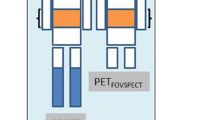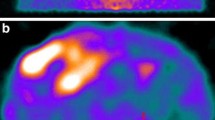Abstract
Purpose
The aim of this study was to assess the value of multimodality imaging using a novel repositioning device with external markers for fusion of single-photon emission computed tomography (SPECT) and computed tomography (CT) images. The additional benefit derived from this methodological approach was analysed in comparison with SPECT and diagnostic CT alone in terms of detection rate, reliability and anatomical assignment of abnormal findings with SPECT.
Methods
Fifty-three patients (30 males, 23 females) with known or suspected endocrine tumours were studied. Clinical indications for somatostatin receptor (SSTR) scintigraphy (SPECT/CT image fusion) included staging of newly diagnosed tumours (n=14) and detection of unknown primary tumour in the presence of clinical and/or biochemical suspicion of neuroendocrine malignancy (n=20). Follow-up studies after therapy were performed in 19 patients. A mean activity of 400 MBq of 99mTc-EDDA/HYNIC-Tyr3-octreotide was given intravenously. SPECT using a dual-detector scintillation camera and diagnostic multi-detector CT were sequentially performed. To ensure reproducible positioning, patients were fixed in an individualised vacuum mattress with modality-specific external markers for co-registration. SPECT and CT data were initially interpreted separately and the fused images were interpreted jointly in consensus by nuclear medicine and diagnostic radiology physicians.
Results
SPECT was true-positive (TP) in 18 patients, true-negative (TN) in 16, false-negative (FN) in ten and false-positive (FP) in nine; CT was TP in 18 patients, TN in 21, FP in ten and FN in four. With image fusion (SPECT and CT), the scan result was TP in 27 patients (50.9%), TN in 25 patients (47.2%) and FN in one patient, this FN result being caused by multiple small liver metastases; sensitivity was 95% and specificity, 100%. The difference between SPECT and SPECT/CT was statistically as significant as the difference between CT and SPECT/CT image fusion (P<0.001). Twenty-seven abnormal SPECT findings in 17 patients could not be initially assigned to organs, but were clearly delineated after image fusion. In 21 patients (40%), clinically relevant information was obtained by image fusion as compared with SPECT alone.
Conclusion
Co-registration of SPECT and diagnostic CT using a cost-effective immobilisation device provides excellent accuracy for tumour detection of endocrine malignancies and is superior to SPECT and CT alone. Image fusion reduces false positive results and can detect additional lesions. Anatomical information provided by CT enables precise localisation of abnormalities observed in SPECT.






Similar content being viewed by others
References
Gabriel M, Decristoforo C, Donnemiller E, Ulmer H, Watfah Rychlinski C, Mather SJ, et al. An intrapatient comparison of 99mTc-EDDA/HYNIC-TOC with 111In-DTPA-octreotide for diagnosis of somatostatin receptor expressing tumors. J Nucl Med 2003;44:708–16
Gabriel M, Muehllechner P, Decristoforo C, et al. 99mTc-EDDA/HYNIC-Tyr3-octreotide for staging and follow-up of patients with neuroendocrine gastro-entero-pancreatic tumors. Q J Nucl Med Mol Imaging 2005;in press
Weber DA, Ivanovic M. Correlative image registration. Semin Nucl Med 1994;24:311–23
Perault C, Schvartz C, Wampach H, Liehn JC, Delisle MJ. Thoracic abdominal SPECT-CT image fusion without external markers in endocrine carcinomas. J Nucl Med 1997;38:1234–42
Amthauer H, Ruf J, Bohmig M, Lopez-Hanninen E, Rohlfing T, Wernecke KD, et al. Diagnosis of neuroendocrine tumours by retrospective image fusion: is there a benefit? Eur J Nucl Med Mol Imaging 2004;31:342–8
Even-Sapir E, Keidar Z, Sachs J, Engel A, Bettman L, Gaitini D, et al. The new technology of combined transmission and emission tomography in evaluation of endocrine neoplasms. J Nucl Med 2001;42:998–1004
Pfannenberg AC, Eschmann SM, Horger M, Lamberts R, Vonthein R, Claussen CD, et al. Benefit of anatomical-functional image fusion in the diagnostic work-up of neuroendocrine neoplasms. Eur J Nucl Med Mol Imaging 2003;30:835–43
Krausz Y, Keidar Z, Kogan I, Even-Sapir E, Bar-Shalom R, Engel A, et al. SPECT/CT hybrid imaging with 111In-pentetreotide in assessment of neuroendocrine tumours. Clin Endocrinol (Oxf) 2003;59:565–73
Schillaci O. Functional-anatomical image fusion in neuroendocrine tumors. Cancer Biother Radiopharm 2004;19:129–34
Schillaci O, Danieli R, Manni C, Simonetti G. Is SPECT/CT with a hybrid camera useful to improve scintigraphic imaging interpretation? Nucl Med Common 2004;25:705–10
Forster GJ, Laumann C, Nickel O, Kann P, Rieker O, Bartenstein P. SPET/CT image co-registration in the abdomen with a simple and cost-effective tool. Eur J Nucl Med Mol Imaging 2003;30:32–9
Decristoforo C, Melendez-Alafort L, Sosabowski JK, Mather SJ. 99mTc-HYNIC-[Tyr3]-octreotide for imaging somatostatin-receptor-positive tumors: preclinical evaluation and comparison with 111In-octreotide. J Nucl Med 2000;41:1114–9
Von Guggenber E, Mikolajczak R, Janota B, Riccabona G, Decristoforo C. Radiopharmaceutical development of a freeze-dried kit formulation for the preparation of [99mTc-EDDA-HYNIC-D-Phe1,Tyr3]-octreotide, a somatostatin analog for tumor diagnosis. J Pharm Sci 2004;93:2497–506
Ozer S, Dobrozemsky G, Kienast O, Beheshti M, Becherer A, Niederle B, et al. Value of combined XCT/SPET technology for avoiding false positive planar 123I-MIBG scintigraphy. Nuklearmediziner 2004;43:164–70
Horger M, Eschmann SM, Pfannenberg C, Storek D, Dammann F, Vonthein R, et al. The value of SPET/CT in chronic osteomyelitis. Eur J Nucl Med Mol Imaging 2003;30:1665–73
Amthauer H, Denecke T, Rohlfing T, Ruf J, Bohmig M, Gutberlet M, et al. Value of image fusion using single photon emission computed tomography with integrated low dose computed tomography in comparison with retrospective voxel-based method in neuroendocrine tumours. Eur Radiol 2005;15:1456–62
Sweeney RA, Bale RJ, Moncayo R, Seydl K, Trieb T, Eisner W, et al. Multimodality cranial image fusion using external markers applied via a vacuum mouthpiece and a case report. Strahlenther Onkol 2003;179:254–60
Pauwels S, Barone R, Walrand S, Borson-Chazot F, Valkema R, Kvols LK, et al. Practical dosimetry of peptide receptor radionuclide therapy with 90Y-labelled somatostatin analogs. J Nucl Med 2005;46:92S–8S
De Juan R, Seifert B, Berthold T, Von Schulthess GK, Goerres GW. Clinical evaluation of a breathing protocol for PET/CT. Eur Radiol 2004;14:1118–23
Schillaci O. Hybrid SPECT/CT: a new era for SPECT. Eur J Nucl Med Mol Imaging 2005;32:521–4
Cholewinski W, Decristoforo C, Mather SJ, Donnemiller E, Gabriel M, Moncayo R. Biokinetics and dosimetry of 99mTc-HYNIC/EDDA-octreotide in tumour patients. Eur J Nucl Med Mol Imaging 2002;29:S656
Decristoforo C, Mather SJ, Cholewinski W, Donnemiller E, Riccabona G, Moncayo R. 99mTc-EDDA/HYNIC-TOC: a new 99mTc-labelled radiopharmaceutical for imaging somatostatin receptor-positive tumours; first clinical results and intra-patient comparison with 111In-labelled octreotide derivates. Eur J Nucl Med 2000;27:1318–25
Acknowledgements
The authors wish to thank the technical assistants of the Department of Nuclear Medicine, Department of Radiology I, University of Innsbruck, who carried out the image fusion procedure. The authors are also grateful to Thomas Lang, Martin Knoflach and Christoph Hinterleitner for invaluable support of data analysis.
Author information
Authors and Affiliations
Corresponding author
Rights and permissions
About this article
Cite this article
Gabriel, M., Hausler, F., Bale, R. et al. Image fusion analysis of 99mTc-HYNIC-Tyr3-octreotide SPECT and diagnostic CT using an immobilisation device with external markers in patients with endocrine tumours. Eur J Nucl Med Mol Imaging 32, 1440–1451 (2005). https://doi.org/10.1007/s00259-005-1875-z
Received:
Accepted:
Published:
Issue Date:
DOI: https://doi.org/10.1007/s00259-005-1875-z




